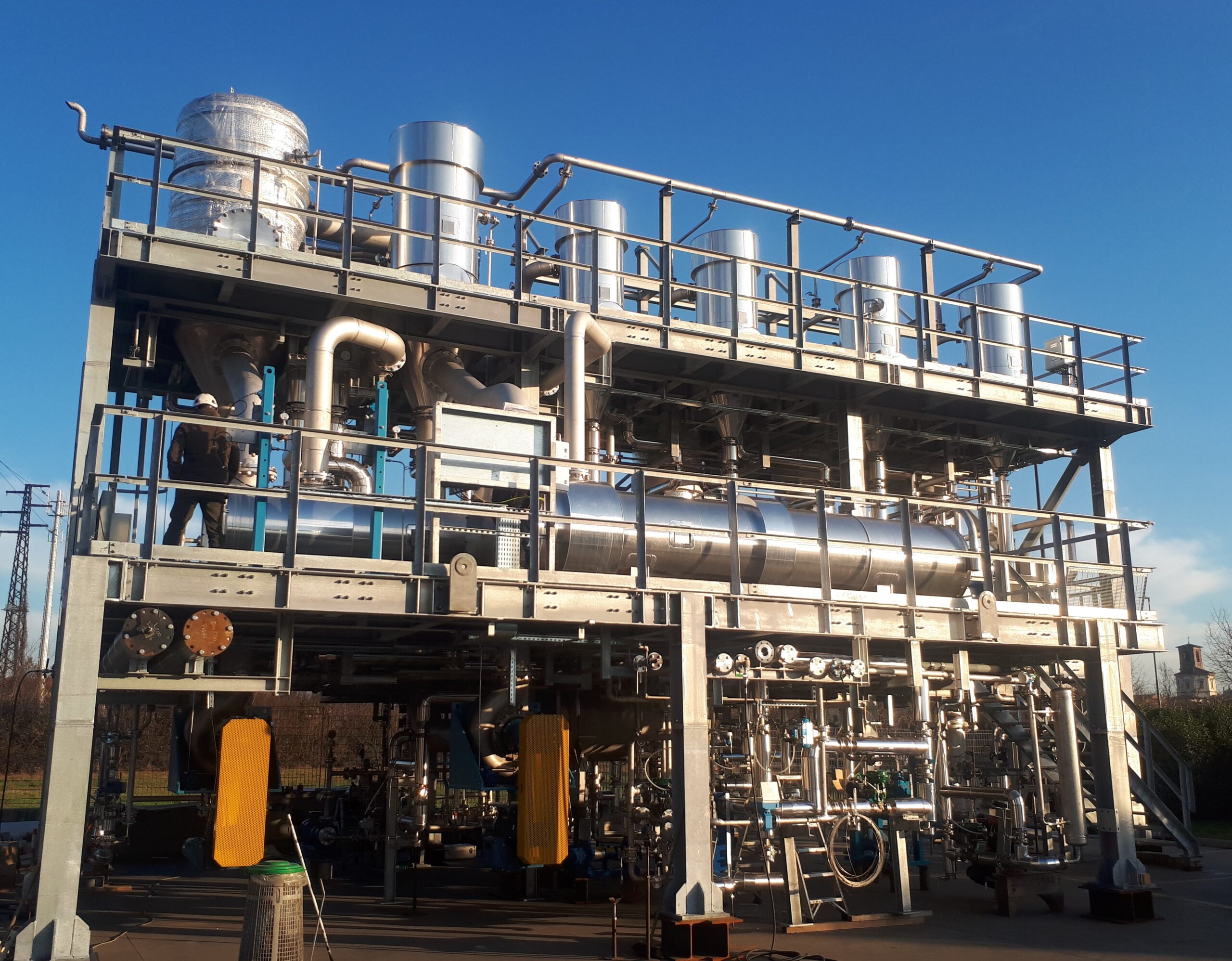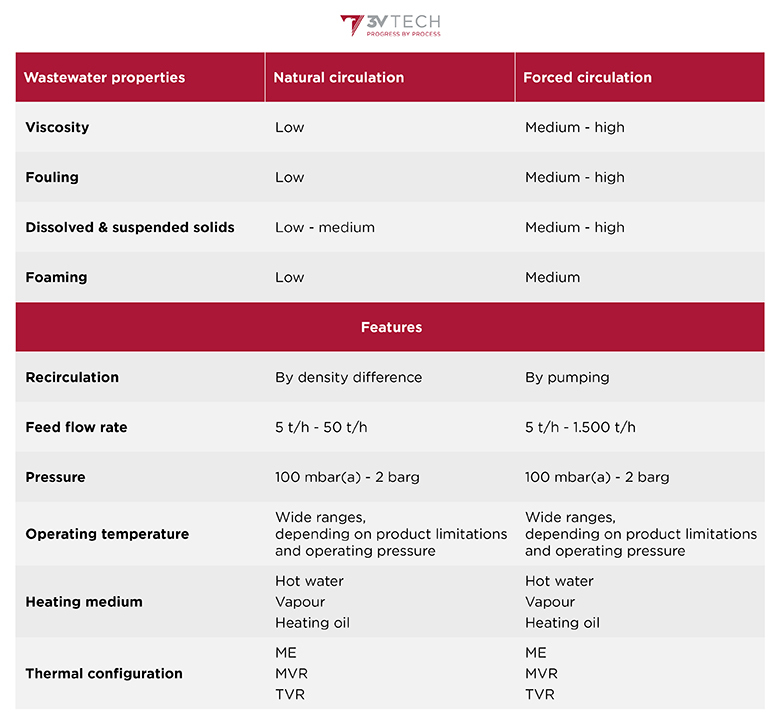Plants
Natural and forced circulation evaporation
Natural and forced circulation evaporation plants are an effective solution for multiple applications as they treat wastewater before discharge, produce clean water for reuse or recycling, according to the minimum or zero liquid discharge (MLD, ZLD) approach, or concentrate wastewater prior to off-site disposal, thus reducing its volumes and costs.
The following streams are separated using evaporation:
- A condensate, free of salts, metals, high boiling point organics, that in most cases can be reused or recycled
- A concentrate for off-site disposal or recovery
Natural circulation evaporators (NCE) are better suited for low viscosity and non-fouling streams, while forced circulation evaporators (FCE) also work well with medium-high viscous fluids having a tendency for fouling.
A combination of the two represents the best balance in terms of investment, operating costs and performances. The forced circulation evaporator is usually recommended for the final evaporation step since the product concentrated in the previous stages has higher viscosity and fouling tendency.
Pre-concentration of process streams is also possible using a falling film evaporator, that can be applied to process streams with low content of suspended solids, salt solutions and low viscosity process streams.
More about our falling film evaporation plants
Energy consumption may be optimised by:
- Multiple effect evaporation (ME)
- Thermal vapour recompression (TVR)
- Mechanical vapour recompression (MVR)
- Using hot water from cogeneration
- Using waste energy (e.g., exhaust gas, steam condensate, process condensate)
- Combining the abovementioned technologies
Overview
Show more Show lessNatural circulation evaporator (NCE)
The natural circulation evaporator is a vertical or horizontal shell and tube heat exchanger where the liquid product to be partially vaporized naturally flows upwards through the tubes, driven by the difference in density between the generated two-phase mixture and the liquid at the evaporator inlet.
The heat duty is transferred by the heating medium (e.g., hot water, live steam or heating oil) on the shell side.
The generated liquid and/or vapour mixture flows to a downstream separator to disengage the vapour phase from the liquid concentrated phase.
A shell and tube exchanger type allows for easy cleanability.
Natural circulation evaporator (NCE) plants
A natural circulation evaporation plant typically consists of:
- The evaporator
- A separator to separate the produced vapour/liquid mixture
- A condenser to condense the vaporized fraction
- A condensate collection vessel and pump
- A pump to transfer the separated concentrated product
When vacuum pressure is needed due to product and/or process requirements, a vacuum group is required.
To recover energy, the feed can be pre-heated by the produced process condensate and/or the heating medium return stream.
Forced circulation evaporator (FCE) and crystallizer
A forced circulation evaporator is a vertical or horizontal shell and tube heat exchanger where the liquid product to be evaporated flows through the tubes under the driving force of a circulation pump loop.
The heat duty is transferred by the heating medium (e.g., hot water, live steam or diathermic oil) on the shell side.
The pumped circulating liquid product is heated when it flows through the heat exchanger. As a consequence, temperature increases and the liquid partially vaporizes when the pressure is reduced in the downstream separator.
Forced circulation evaporators can also be used as crystallizers. Crystals grow inside the separator and special separator designs are used to handle crystals in the recirculated crystal slurry.
A shell and tube exchanger type allows for easy cleanability.
Forced circulation evaporator (FCE) plants
A forced circulation evaporation plant is typically composed of:
- The evaporator
- The circulation pump to enable the process
- A condenser to condense the vaporized fraction
- A condensate collection vessel and pump
- A concentrate/slurry pump to transfer the separated concentrated product
When a vacuum is needed due to product and/or process requirements, a vacuum group is used.
To recover energy, the feed can be pre-heated by the produced process condensate and/or the heating medium return stream.
Forced circulation evaporator plants are also an optimal solution to work as crystallizing units for saline wastewater: crystals are separated from the recirculated slurry thanks to special separators.
A decanter/centrifuge is required to separate the solid crystals from the mother liquor to obtain a dry or wet salt cake.
Multiple effect (ME) natural or forced circulation evaporation plants
Multiple effect natural or forced evaporation plants usually consist in a series of evaporators operating at progressively lower pressure, to allow using the vapour generated in the upstream effect as the heating medium of the next effect.
The type of evaporator is selected according to the specific application and the solid content in the effluent.
Live steam or another heating medium (e.g., hot water, heating oil) is required for the first evaporation step only.
Vapour from the final effect is condensed by cooling water.
The number of effects is limited by material corrosion and the boiling point elevation (BPE) of the concentrate stream. For condensate or concentrate recovery, also thermal degradation can be a relevant aspect to be considered.
Features and rangeability
Show more Show lessNatural or forced circulation evaporation plants are customised according to the customer’s needs and expectations. Typical features are shown below.
Also supplied as skid mounted units to minimise installation operations at the customer’s site.
The most suitable material is selected based on the nature of the process stream, wastewater composition and operating conditions.
The main materials usually selected are the following:
- Stainless steel
- High performance alloys
- Titanium
A wide range of services from technical feasibility studies to revamping existing plants is also available.
Depending on the wastewater composition and the treated water’s (the condensate) end use, the evaporation plant is coupled with other process technologies to achieve the desired water quality.
Key benefits
Show more Show less- Minimum up to zero liquid discharge
- Water reuse or recycling
- Less wastewater off-site disposal volumes and costs
- Potential recovery of valuable substances
- Customised design
- Combination with other process units
- Bespoke thermal configuration
- High automation level
- Remote assistance
- Easy cleanability
Specific benefits
- Natural circulation evaporators: power consumption reduction since no pump is required.
- Forced circulation evaporators: reduced maintenance thanks to reduced fouling.
The above benefits are further increased in our unique “multiple effect natural + forced circulation evaporation” arrangement, providing maximum energy savings, thanks to:
- Using the vapour generated in the upstream effect as the heating medium of the next effect
- Condensate heat recovery
Applications
Show more Show lessA wide range of applications is possible for both municipal and industrial wastewater, having a medium-high content of dissolved solids such as salts, metals or other organic contaminants, and for different wastewater end use:
- Discharge to surface, sewer or other treatment plant
- Reuse/recycling
- Concentration
- Solvent recovery
Natural and forced circulation evaporation plants address the needs of the following different industries:
- Chemicals
- Food & beverage
- Landfill
- Mining
- Oil & Gas
- Pharmaceutical
- Power
A broad range of industrial processes generates extensive wastewater compositions to be treated and, whether easy or difficult to treat, each wastewater requires a customised process and a bespoke plant design.
We provide support to our customers conducting tests at the laboratory and pilot plant scale, as well feasibility studies leveraging our R&D centre and multi-disciplinary teams.
References

